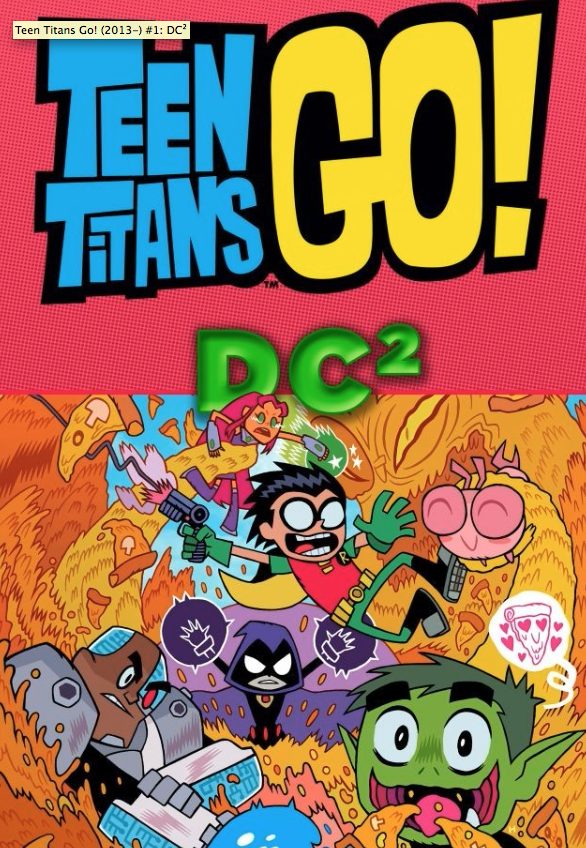
On Saturday, DC2 released the first issue of a new Teen Titans series based on the Saturday morning cartoon Teen Titans GO! Although they will eventually be printed, this initial ComiXology version (99¢) uses simple interactive techniques to aid the story telling.
The story is another fun read from the kid-centered world of the Teen Titans, revolving around the issue of who has stolen Cyborgs sandwich. Probably not the story for fans looking for dystopian futures, but a good read to share with your younger kids.
This is not the first time DC2 has taken advantage of the power of digital sequential presentation–Batman ’66 has been going like gangbusters for a few months. I had a chance to review the new comic (see video) and pose a few questions to writer Sholly Fisch and artist Ben Bates about their experience with interactive comics and how they approach this medium.
Review
Review: Teen Titans Go #1 on DC2 from Jason Cranford Teague on Vimeo.
Interview
GeekDad: Was this your first time working on an interactive comic?
Ben Bates: This was my first.
Sholly Fisch: Yes and no, actually. Several years ago, I designed and wrote a bunch of interactive comics for a National Academy of Sciences web site about female scientists, in which popups and some bits of limited animation were embedded in the comics. But, naturally, the technology’s a whole lot more sophisticated now. So my past experience gave me kind of a running start for Teen Titans GO!, but I’m also learning stuff and picking up some new skills along the way. It’s not a bad combination–as long as I can keep my assignments straight and resist the temptation to stick Madame Curie in the Teen Titans.
GeekDad: How is illustrating and writing the narrative for an interactive comic different than standard sequential art narrative?
Ben Bates: I was excited to learn it’s not a question of being different. The comic is also going to print, so, just like every other comic I’ve done, my first responsibility is to create layouts as a standard sequential art narrative. Once I’ve got a normal old comic, then I start adding in the interactive stuff. The process is really fun and free since I’ve already solved all the storytelling problems during the standard layout phase and all I need to concern myself with is how much cool stuff I can add.
Sholly Fisch: Well, obviously, a lot of the storytelling is the same either way. You still need a fun, engaging story, good interplay between the characters, and so on. But there are some real differences too. The most obvious one is probably that, in an interactive comic, you can zoom in or out, or have things reveal themselves in a panel after a tap or swipe, which offers new opportunities for gags or surprises. In writing stories for Teen Titans GO!, I’ve been setting up juxtapositions between panels a little differently than I usually do, to take advantage of those opportunities.
One of the more subtle differences, though, is that screen size on a tablet is proportioned differently than a standard page of a traditional paper comic book. So, when a comic is published in both formats like Teen Titans GO!, you have to approach the page layout a little differently. For example, if you look at the paper version, you’ll see that there are no full-page splash panels. That sort of thing has pushed me to pace the stories a bit differently, but most readers will probably never notice the change.
GeekDad: What’s the coolest new thing you could do in this format you couldn’t do in print?
Ben Bates: The opportunity to deliver and explore more of the story. With a printed comic, you’re literally getting less of the experience. In the interactive comic, I’m no longer limited by the physical space of the page so I can create beyond the borders of any given panel. A panel showing only the upper body suddenly becomes a full body shot. Maybe a panel hidden in the gutter space of the printed version can be showcased in the interactive. Instead of a panel with only one drawing to represent a character with multiple balloons of dialog, the image can change to correctly match the tone of its current balloon. With each swipe of the screen of an interactive comic I can squeeze in one more drawing, fine tune the pacing, and hopefully take the reader deeper into the experience.
Obviously there’s a balance to be struck with this new opportunity and its necessary to refrain from adding meaningless extra content. Nobody wants to have to swipe 23 times to get through a single panel. But I think there’s a skill to master here that can make interactive comics better than print.
Sholly Fisch: For one thing, you can jump back and forth between the comic and playing Temple Run…
Really, I’ve been having fun playing around with the possibilities of the medium–characters transforming from panel to panel, and stuff like that. Probably my favorite bit so far is a bit in my first story, where you can toggle back and forth between two of the panels to create a pseudo-animated effect. Of course, I’ve only seen the art on paper so far (well, in PDFs on the screen, but you know what I mean), so I have no idea yet whether the effect will be really neat, or whether I’ll just fall on my face. But hey, taking that chance is half the fun.



